NASA engineers are implementing measures to ensure that the Voyager spacecraft continue their interstellar exploration for several more years.
One concern being addressed is the accumulation of fuel residue in narrow tubes within some of the thrusters on both Voyager 1 and Voyager 2. These thrusters are crucial for maintaining the spacecraft's antenna alignment with Earth. This issue of residue buildup has been observed in a few other space missions.
Additionally, a software patch is being uploaded to prevent a recurrence of a glitch that affected Voyager 1 last year. This patch aims to safeguard against similar issues in Voyager 1 and its counterpart, Voyager 2.

Voyager's Thrusters
The thrusters play a pivotal role in orienting the spacecraft's antennas towards Earth for communication. As the spacecraft rotate, the thrusters automatically adjust to maintain this alignment.
Propellant flows through fuel lines and then smaller propellant inlet tubes within the thrusters, which are significantly narrower, according to NASA.
Over time, each thruster firing leads to a gradual buildup of propellant residue. To counteract this, the mission has adjusted the spacecraft's rotation range, allowing for slightly more movement in each direction before thruster firings. This reduces the frequency of firings.
These adjustments, made through commands in September and October, permit the spacecraft to move nearly one degree farther in each direction than previously possible. The mission has also opted for fewer but longer firings, further minimizing the total number of thruster operations.
NASA notes that while these changes may occasionally result in minor data losses, akin to brief disruptions in a phone call, the team believes this plan will ultimately yield more data from the Voyagers over time.
Engineers cannot predict precisely when the thruster propellant inlet tubes may become entirely clogged. However, with these precautions, they estimate this won't occur for at least another five years, potentially even longer. The team remains prepared to take additional steps in the future to extend the thrusters' operational lifespan.
Unprecedented Challenges
Linda Spilker, project scientist for the mission at NASA's Jet Propulsion Laboratory, notes that at this stage in the mission, the engineering team faces unprecedented challenges and continues to devise creative solutions.
It is worth noting that in 2022, Voyager 1's onboard computer exhibited anomalies in status reports, though it continued to operate normally. The issue stemmed from the attitude articulation and control system (AACS) misdirecting commands. The software patch is a precautionary measure to prevent a recurrence of this problem.
Voyager 1 and Voyager 2 have ventured over 15 billion and 12 billion miles from Earth, respectively. Due to the considerable distance, the patch instructions will take over 18 hours to reach the spacecraft.
NASA said that to minimize risks, extensive efforts have been made to ensure the code is error-free. Voyager 2 will receive the patch first, acting as a test before implementing it on Voyager 1.
The Voyager mission has far surpassed its initial expectations, exploring Saturn, Jupiter, Uranus, and Neptune as it was originally slated for four years. In 2012 and 2018, Voyager 1 and Voyager 2, respectively, reached the heliosphere boundary, a milestone in interstellar space exploration.
Related Article : NASA's 'Longest Operating Mission In Space:' Voyager Achieves 45 Years In Exploring The Universe!

ⓒ 2025 TECHTIMES.com All rights reserved. Do not reproduce without permission.




